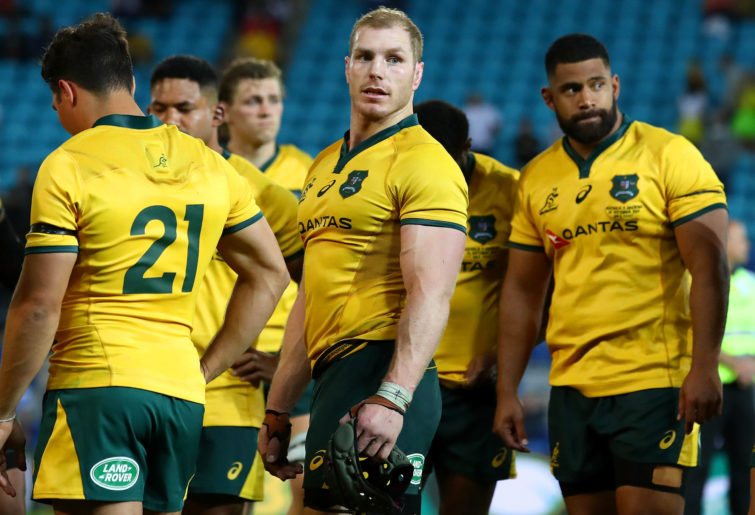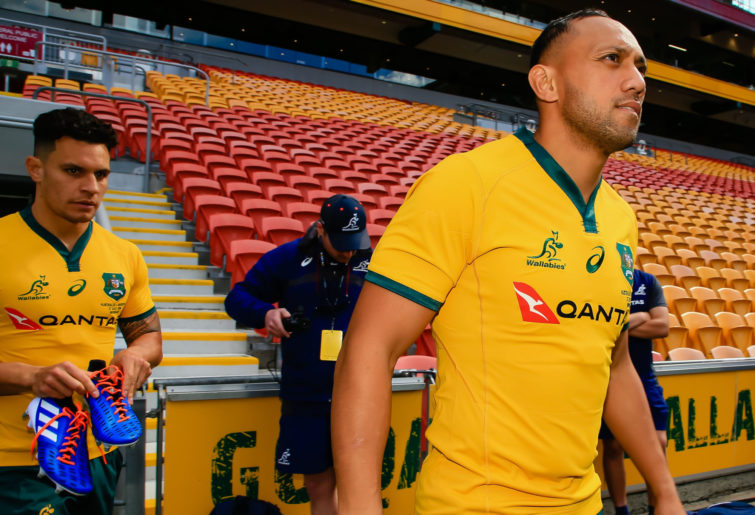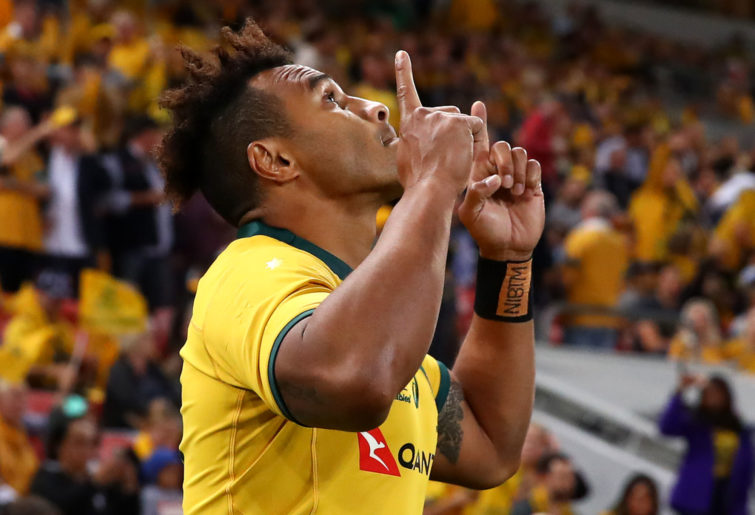The Wallabies’ 16-10 victory against the Pumas was the victory the side needed to have if they were to go into the 2019 Rugby World Cup with any confidence of making a strong showing.
Even more important than the result, though, was the fact that Michael Cheika and his two other selectors, Michael O’Connor and Scott Johnson, by trial and error, have found a starting side of some quality.
This side needs to be exposed to the All Blacks in the next two Bledisloe Cup Tests to steel them for the sort of challenges that will need to be met and overcome in Japan.
It is clear now, after two tough Tests in 2019, a pack made up of two big loose forwards, Isi Naisarani (a potential World Cup standout) and Lukhan Salakai-Loto, two monster second rowers Rory Arnold and Izack Rodda and a tough, abrasive and strong front row of Sekope Kepu, Folau Fainga’a and Scott Sio gives the Wallabies that hardness and some skills that potential World Cup winners must have.

(Photo by Jason McCawley/Getty Images)
The monsters dominated the lineouts in the first half and when Taniela Tupou came on in the second half the Wallabies started to smash the Pumas in the scrums. The point here is that last week, the All Blacks could not exert a significant scrum pressure against the Pumas.
And as Rod Kafer pointed out repeatedly in his commentary, the big six bruisers, with their hard shoulder running and tackling, allowed Michael Hooper to go back to the traditional No.7 role of tackling, pilfering, and running and covering out wide.
Hooper had his best Test for the Wallabies in years. For the first time in a couple of years, he looked the part of a complete number 7.
Where does this leave David Pocock, presuming he recovers in time from his injuries?
Well, I remain a dissident in the matter of Pocock and his relevance to the Wallabies hopes in the RWC.
Earlier in the year when he came back from his sabbatical and some rugby in Japan, there was talk about how he had added to his running and passing game.
The ‘evidence’ of this was not obvious to me.
Pocock’s best role for the Wallabies, if he is to be in the squad, is to come on as a finisher. Turnovers, his speciality, are crucial at the end of a Test when a lead is being defended or some points have to be scored.
This role is not to be scorned and playing it effectively could be Pocock’s last gift to Australian rugby and the Wallabies.

(Photo by Cameron Spencer/Getty Images)
The final point here is that Michael Hooper’s captaincy was much better than usual, matching in a way the improvement in his overall game.
For once Hooper took the points allowing Christian Lealiifano to kick the Wallabies out to enough points to ensure that the late surge by the Pumas was able to resisted, just.
It was pointed out in the commentary, too, that Lealiifano was making his first start for the Wallabies as a number 10.
He nailed the position with one of the better displays by a Wallaby number 10 since the glory days of Stephen Larkham.
His goal kicking was spot on. His passing was good. His defensive work was excellent, particularly when he worked with Marika Koroibete to somehow stop what looked like being an inevitable Pumas try before the scrambling and smart defence killed it off.
And I always have a soft spot for designated playmakers who pull off great set-piece moves.
Late in the first half, Lealiifano took the ball to the line, dummied to his left to a runner cutting in and then delivered a sympathetic pass to Korobeite racing up on the outside.
A couple of passes later from Korobeite and Kurtley Beale, both them actually quite poor, saw Reece Hodge cross over for the Wallabies’ only try.

(PATRICK HAMILTON/AFP/Getty Images)
Lealiifano was made to look good, admittedly, by the terrific play of Will Genia.
The Wallabies halfback reached back into the past to produce on his great games for his country.
Recently, there has been the worry that he has been too concerned about looking after himself, in the manner of George Gregan in 2003, keeping himself ready for his post-Wallabies career in Japan.
But on Saturday night, Genia was back to his magical best. He probed. He picked out runners. When he kicked, he kicked long and effectively. He controlled the flow of play and the attacking options for the Wallabies, rather than just shovelling the ball out or kicking it away.
Last week, I was virtually on my own among the rugby writers in not praising to the skies the performance of Nic White.
Now, I hope, the rugby writers can understand the point I was trying to make.
The Australian game shouldn’t and hasn’t been based around halfbacks whose best skill is to kick the ball away.
The Australian game, unlike the New Zealand game, is for the halfback to be the controller of the backline. When a halfback cannot do this, like White, the backline struggles to function.
Hopefully Genia’s return to form is not a flash in the pan. For when he plays with the same sort of attacking skills, as he did against the Pumas, the Wallabies immediately become a formidable team.

(Photo by Cameron Spencer/Getty Images)
The system of big centres, with Samu Kerevi and Tevita Kuridrani, gives the Wallabies the blockbusting power in the middle of the field to puncture the rush defence that looks like being a feature of RWC 2019.
Curiously, the Wallabies do not appear to be willing to embrace the rush defence system that England, Wales, Ireland, New Zealand and South Africa have adopted.
Again, Rod Kafer in his commentary suggested that this was because the Wallabies had conceded a large number of line breaks in previous Tests and preferred what might be called a more passive hold-the-ground defence, absorbing attacks rather than disrupting, to limit the chances of opposition breakouts.
Tim Horan made a good point that if this passive-aggressive defence by the Wallabies is used by a Wallabies side against a strong attacking side like the All Blacks, there could be a points deluge.
We will see, I guess. What seems to be clear is that the All Blacks are still struggling to work out how to defeat the strong rush defence that England, Ireland, Argentina and South Africa have thrown at them last year and this year.
As for the back three, of Reece Hodge, Marika Koriobete and Kurtley Beale, this seems to be the best-balanced group the Wallabies can present as starters.
Hodge is the fullback/wing, a tallish player who can defend against the bomb attacks. Koriobete is abrasive, tough and energetic on defence and attack.
And Beale is Beale, often terrific on attack and as a playmaker and often just missing on defence or under the high ball.
The point here is that teams need a player or two like Beale who can do the brilliant thing that turns a game. And, significantly, a high proportion of Beale’s Test tries have come when he starts at fullback, his best position given his strengths and weaknesses.

(Chris Hyde/Getty Images)
I think Matt Toomua’s short appearance on the field was enough to suggest that he shouldn’t be included in the World Cup squad.
He is too small for the modern centres game. Lealiifano and Bernard Foley are the obvious number 10s, with Beale a back-up in an emergency.
The case for James O’Connor is slightly different.
He was only on the field for a few minutes and floundered one defensive situation and then made a strong tackle.
I don’t know whether a bits-and-pieces player like O’Connor is what the Wallabies actually need.
Again, I dispute the conventional wisdom of the rugby journalists that Matt Giteau was a success in the 2015 World Cup. He played in the final but was injured early on and a bigger player at inside centre would have helped the Wallabies cause much better.
It is nearly two-and-half years ago that O’Connor was arrested with the former All Black Ali Williams in Paris on the suspicion of attempting to buy cocaine. He seems to have turned his rugby and his life around since then with his behaviour and play at the Sale Sharks club.
But does O’Connor provide some sort of answer, like Giteau, to a problem that isn’t really apparent within the Wallabies squad? I don’t think so.

































































































